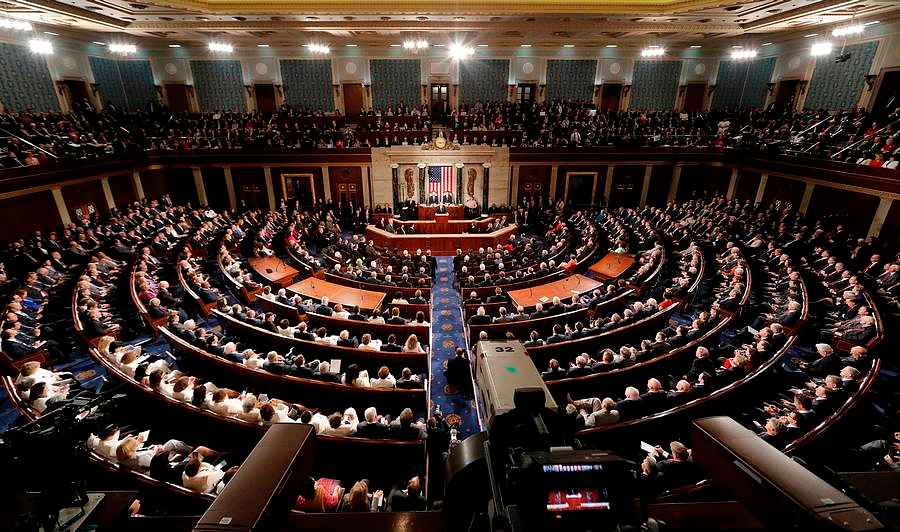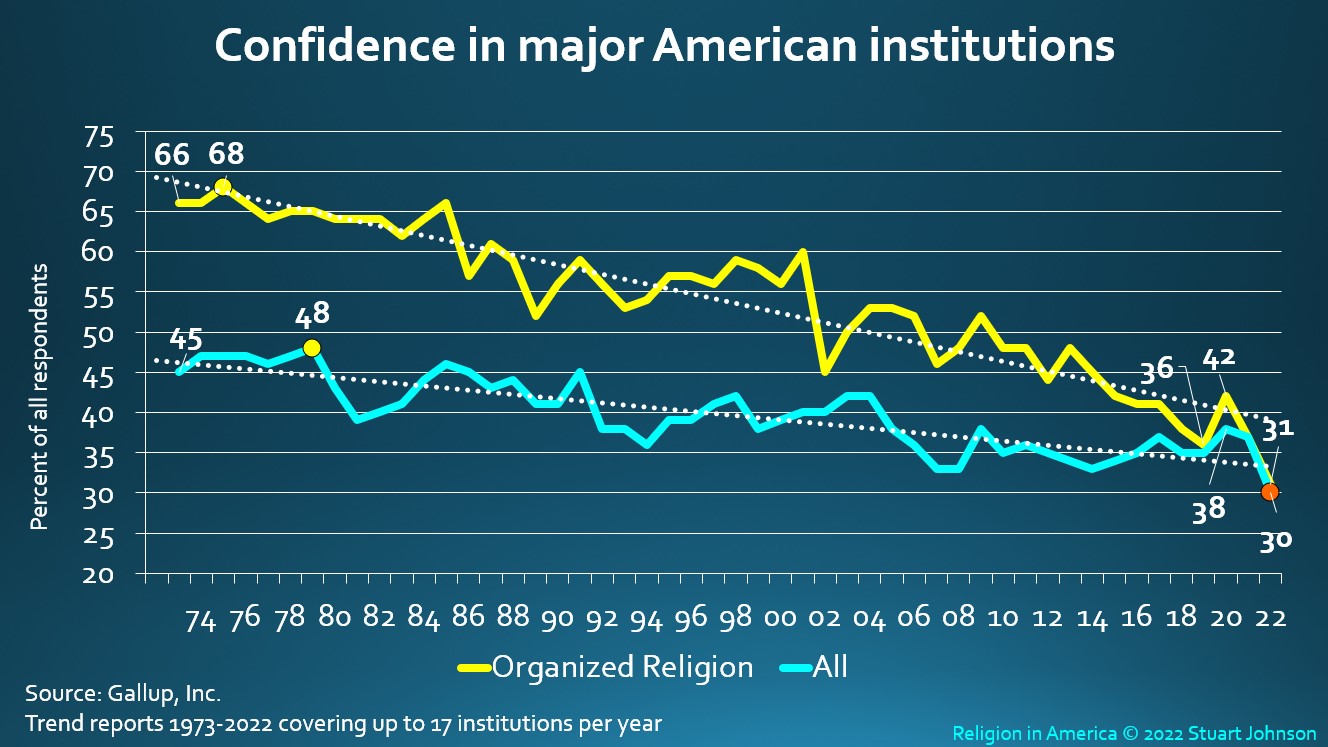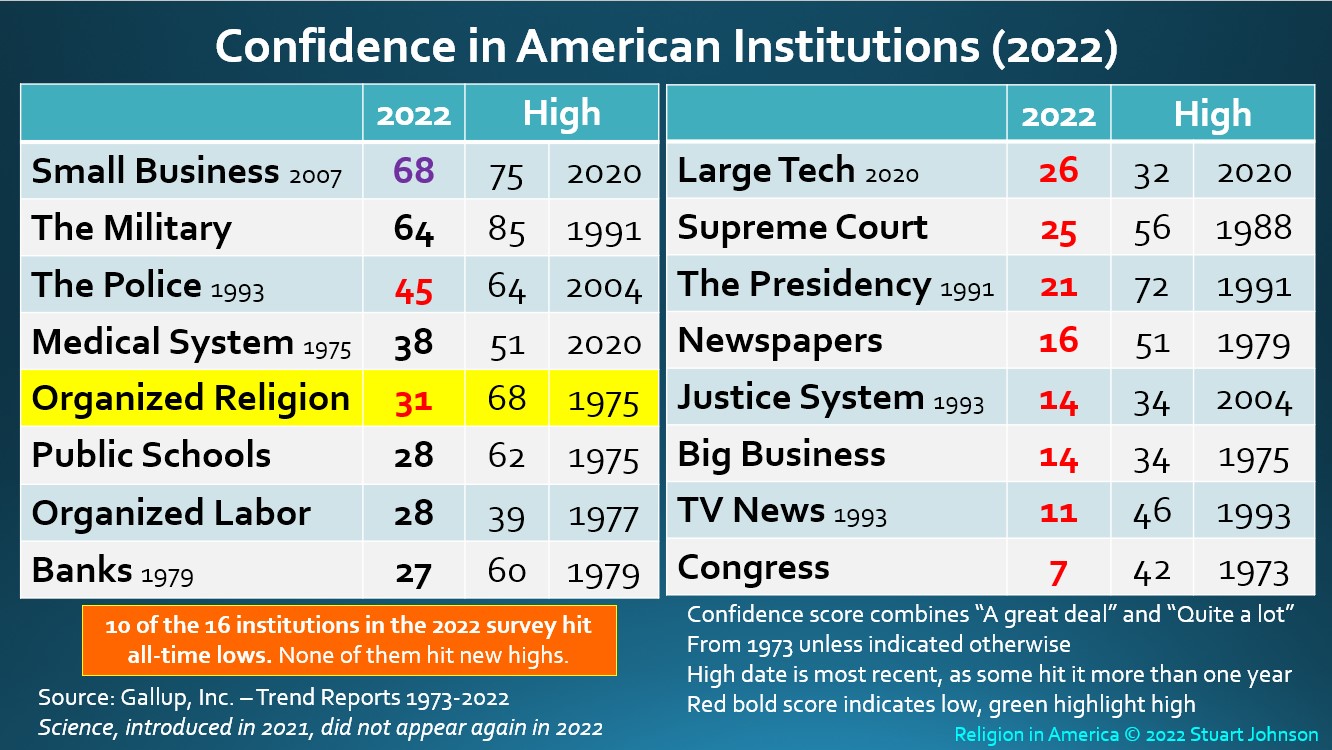
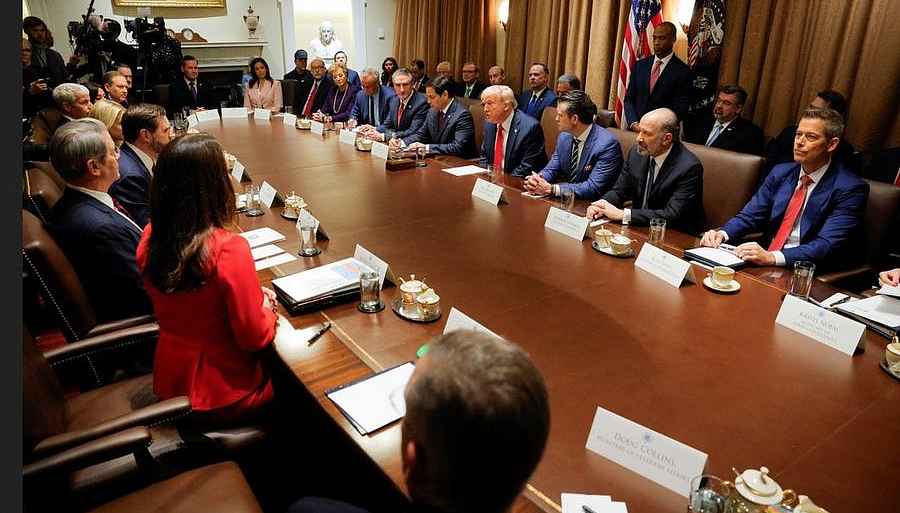




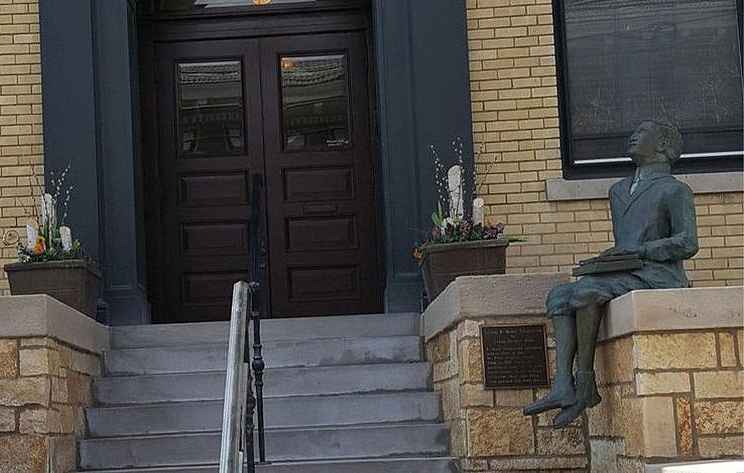
See listing of Recent and Most Popular articles on the Home Page
Our World
Category: Trends / Topics: Business • Demographics • Government • History • Religion • Research • Statistics • Trends • Trust
Who Do You Trust? (2022)
by Stu Johnson
Posted: September 17, 2022
The Gallup survey on Confidence in American Institutions shows 10 of 16 hitting all-time lows in 2022. That begs the question, do we just shake our heads as we point to 'THEM,' or ask 'what does this say about US'?…
The following is an excerpt from my Religion in America report. This section is based on the 2022 update of the annual Gallup survey of confidence in American institutions. While my focus is religion, this section covers all of the institutions included in the Gallup survey.
Gallup began its annual survey of confidence in American institutions in 1973. The question is stated "Now I am going to read you a list of institutions in American society. Please tell me how much confidence you, yourself, have in each one -- a great deal, quite a lot, some, very little, or none?" The score in the charts and referred to as being confident represents those who responded "a great deal" or "quite a lot."
Survey results are released each July, so results may reflect events in the first two quarters of a given year as noted below.. It is also important to point out that the results of any public opinion survey have a margin of error determined by sample size and methods of selecting participants, For this Gallup survey, the margin of error is typically 4- to 5-percent. Taken together, these factors indicate why trends over time are more significant than relatively small changes from year to year.
In 1973, the first year Gallup conducted its annual measure of confidence in major institutions, "the church or organized religion" was rated the highest among 15 institutions, 21 points higher than the average for all 15 (and clearly above the margin of error). Over the decades since then, however, overall confidence has steadily fallen, with Organized Religion declining at a more rapid pace than the others combined—to the point that Organized Religion in 2022 is only one point higher than all institutions surveyed (though that is within the margin of error, which is ±1.5 points at that level ).
Organized Religion continued to rank first through 1985, then fell below 60%. Among the reasons: Televangelist scandals, child molestation by priests; then a general decline in religiosity continued the downward trend (as scandals in Catholic and Protestant churches continued). Organized Religion dropped 32% from its high of 68% in 1975 to 36% in 2019). In 2020, the survey reflected the early months of COVID with many congregations under lockdown and scrambling to stay connected through various online options, Organized Religion rebounded to 42% in 2020, but settled back to 37% in 2021 even as many congregations were opening up. In 2022 Organized Religion hit an all-time low of 31%—bringing the total decline from high to low to 37-points, down to less than half of where it started.
At the same time that Organized Religion has been racing to the bottom, confidence for all institutions in the survey has fallen 18% from a high of 48% in 1979 to its new low of 30% in 2022. There was a noticeable upturn in 2020 across two-thirds of the 15 institutions, most likely attributable to positive attitudes toward the responses of those institutions to the COVID-19 pandemic. A counterpoint, however, was the downturn for Police and TV News, with George Floyd's death at the hands of police in Minneapolis occurring shortly before the survey results were released in July.
While 10 of the 16 institutions have had 50% or more confidence at some point since their inclusion in the survey, only two can make that claim now. In 2022 all 16 institutions declined in confidence from 2021 and ten of the sixteen hit all-time lows.
There have been numerous ups and downs in confidence across institutions throughout the 50-year history of the survey. What we can see in the past three years is worth noting. In 2020, with the survey taken in the early months of the COVID pandemic, confidence in several institutions increased significantly in what appeared to be an expression of empathy for the people in those institutions affected by lockdowns and restrictions imposed by efforts to cope with the virus. The "COVID bump" was just that however, as things began to turn downward in 2021 and accelerated into 2022, with all institutions down and 10 of them at their all-time lows.
An interesting side note for 2022 is what I see as a "ripple effect" in responses that keeps the Overall Confidence (including Some) in a majority
for all but the lowest ranking institutions. For most of the institutions in 2022, the downward drop in Confidence Score is a result of Great Deal going down, while Quite a Lot remains close to or at 2021 levels. The downturn in Great Deal ripples down to an increase in Some, thus keeping Overall Confidence close to 2021 levels. I see this as a growing "lukewarm" sense of confidence with the majority of the institutions in the Gallup survey. Only the lowest begin to move into majorly Very Little or None. This is reflected somewhat in what follows, but you can find much more detail in the "Digging Deeper" links at the bottom of the page.
In 2021, Science was added as the 17th institution, taking third place, pushing the rest of the list down at least one place from their 2020 rankings. Science was dropped in 2022 (I commented last year that I did not think it would last because "science" is not like the other institutions which can be associated with specific organizations. Large Tech was added in 2020 and remains in the list—it can be identified with companies that rival government in power: Amazon, Apple, Facebook, Google, Microsoft and Twitter, among others, all of them part of yet distinct from Big Business, so worthy of their own status as an institution. .
Looking at the 2022 results, Small Business and The Military stayed in the top two spots, but each were down in score from 2020 when Small Business hit its high. In fact, all 16 institutions are down in score from 2021. Because of the presence of Science last year, 12 of the institutions rose in rank despite declining confidence (8 would have simply stayed in place compared to last year were it not for the one year appearance of Science at number 3. Falling in rank were the Supreme Court, down 11 points and two ranks to Number 10, and The Presidency, down 15 points and six ranks to Number 11 (it was only institution to move up in rank last year). .
Organized Religion lost all of its 2020 bounce, coming in at an all-time low of 31 for 2022. It did manage to move up two ranks, due to the one-year tenure of Science at number 3 last year and the fall of The Presidency to an even-lower score and ranking (most years it was behind Organized Religion, but last year was just ahead of it by rank).
Despite all the media coverage that might lead you to assume a stampede in the other direction, The Police recouped third place from Science, which did not return in this year's survey. It did drop six points, establishing a new all-time low at 45 (the highest of the new lows this year).
Including "Some" confidence in the score would bring a number of the weakening institutions above 50%, but that is only stretching things to reach levels once achieved by "A Great Deal" and "Quite a Lot." An analysis in the Digging Deeper section will show trend charts for individual institutions that makes the distribution by response over time more clear.
Spanning more than 20 points between their high and low scores are 13 of the 16 institutions for 2022 (last year there were 10). Six hit their low in 2022, Criminal Justice hit it in both 1993 and 2022. Five never had majority confidence (over 50): Congress, TV News, Criminal Justice System, Big Business and Organized Labor.
- The Presidency - 49 points between its high of 72 in 1991 and low of 23 in 2022 - median score: 39 - 23 now
- Banks - 39 points between its high of 60 in 1979 and low of 21 in 2012 - median score: 41 - 27 now
- Organized Religion - 37 points between its high of 68 in 1975 and low of 31 in 2022 - median score: 56 - 31 now
- Public Schools - 36 points between its high of 62 in 1975 and low of 26 in 2014 - median score: 39 - 28 now
- Congress - 35 points between its high of 41 in 1973 and low of 7 in 2022 - median score: 24 - 7 now
- The Military- 35 points between it high of 85 in 1991 and low of 50 in 1981 - median score: 66 - 64 now
- Newspapers - 35 points between its high of 51 in 1979 and low of 16 in 2022 - median score: 33 - 16 now
- TV News - 35 points between its high of 46 in 1993 and low of 11 in 2022 - median score: 26 - 11 now
- The Supreme Court - 31 points between its high of 56 in 1985 & 1988 and low of 25 in 2022 - median score: 45 - 25 now
- The Medical System- 20 points between its high of 51 in 2020 and low of 31 in 2007 - median score: 39 - 38 now
- Organized Labor - 20 points between its high of 39 in 1971 and low of 19 in 2007 & 09- median score: 26 - 28 now
- Criminal Justice System - 20 points between its high of 34 in 2004 and low of 14 in 1993 & 2022 - median score; 24 - 14 now
- Big Business - 20 points between its high of 34 in 1975 and low of 14 in 2022 - median score: 24 - 14 now
What does the overall decline of confidence say about the future of our society when we have so little trust in our bedrock institutions? What can the Christian church (and other faith communities) do at the individual and local level to restore trust when organized religion itself has fallen so far?
![]()
See more details about CONFIDENCE IN MAJOR AMERICAN INSTITUTIONS
Part 1: Trends, Comparison to Medians and Highs, Including "Some", Breakdown of Historic Highs and Lows
Part 2: Demographic breakdown of responses for each institution
Part 3: Trend line of responses for each institution
Part 1 was last updated August 31, 2022, Part 2 was added September 9, 2021 and Part 3 was updated September 14, 2022.
The next annual updates will be posted by August 2023.
Search all articles by Stu Johnson
Stu Johnson is principal of Stuart Johnson & Associates, a communications consultancy in Wheaton, Illinois. He is publisher and editor of SeniorLifestyle, writes the InfoMatters blog on his own website and contributes articles for SeniorLifestyle. • Author bio (website*) • E-mail the author (moc.setaicossajs@uts*) • Author's website (personal or primary**)* For web-based email, you may need to copy and paste the address yourself.
** opens in a new tab or window. Close it to return here.
Posted: September 17, 2022 Accessed 459 times
![]() Go to the list of most recent Our World Articles
Go to the list of most recent Our World Articles
![]() Search Our World (You can expand the search to the entire site)
Search Our World (You can expand the search to the entire site)
![]() Go to the list of Most Recent and Most Popular Articles across the site (Home Page)
Go to the list of Most Recent and Most Popular Articles across the site (Home Page)
 Loading requested view...
Loading requested view...